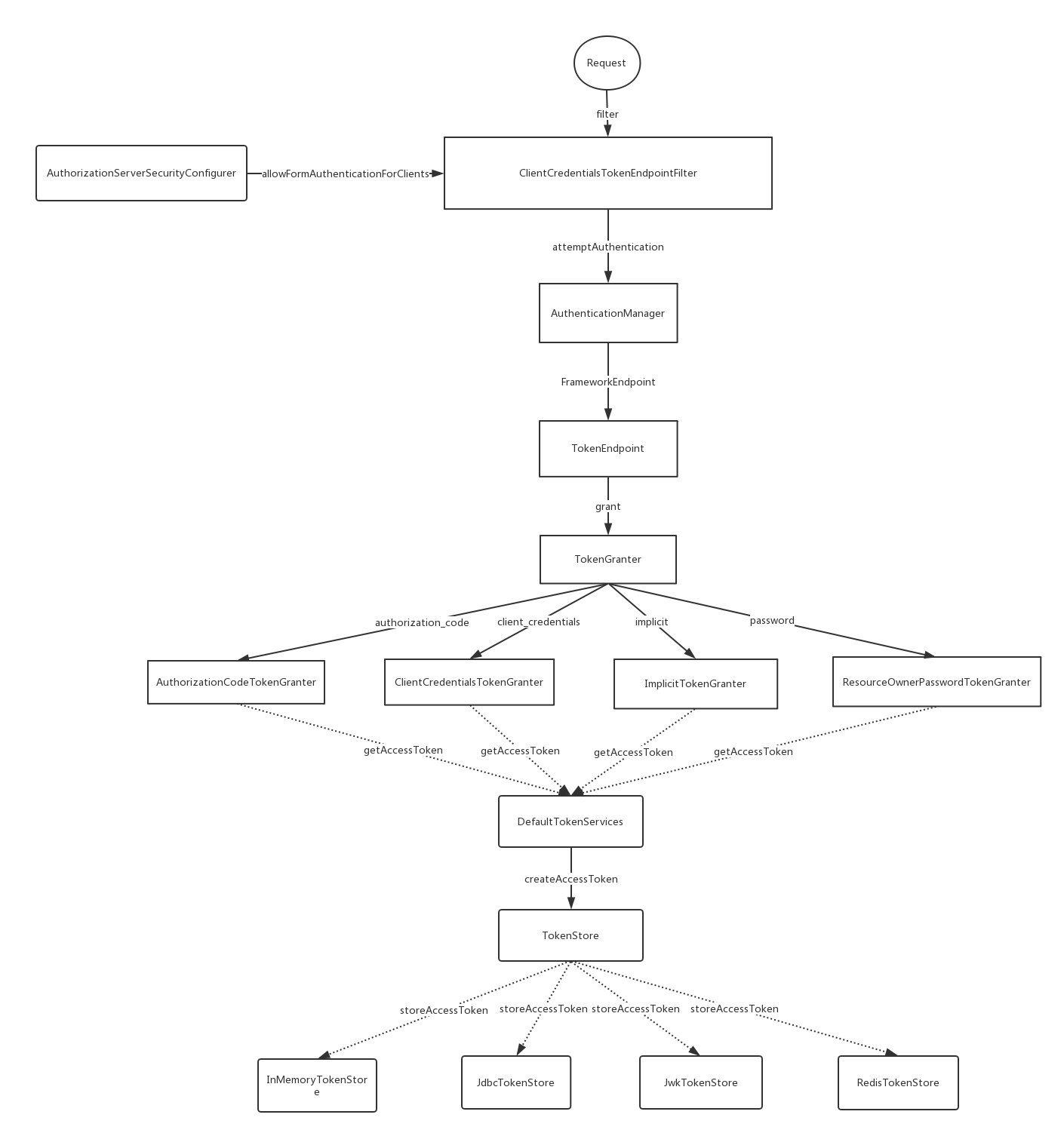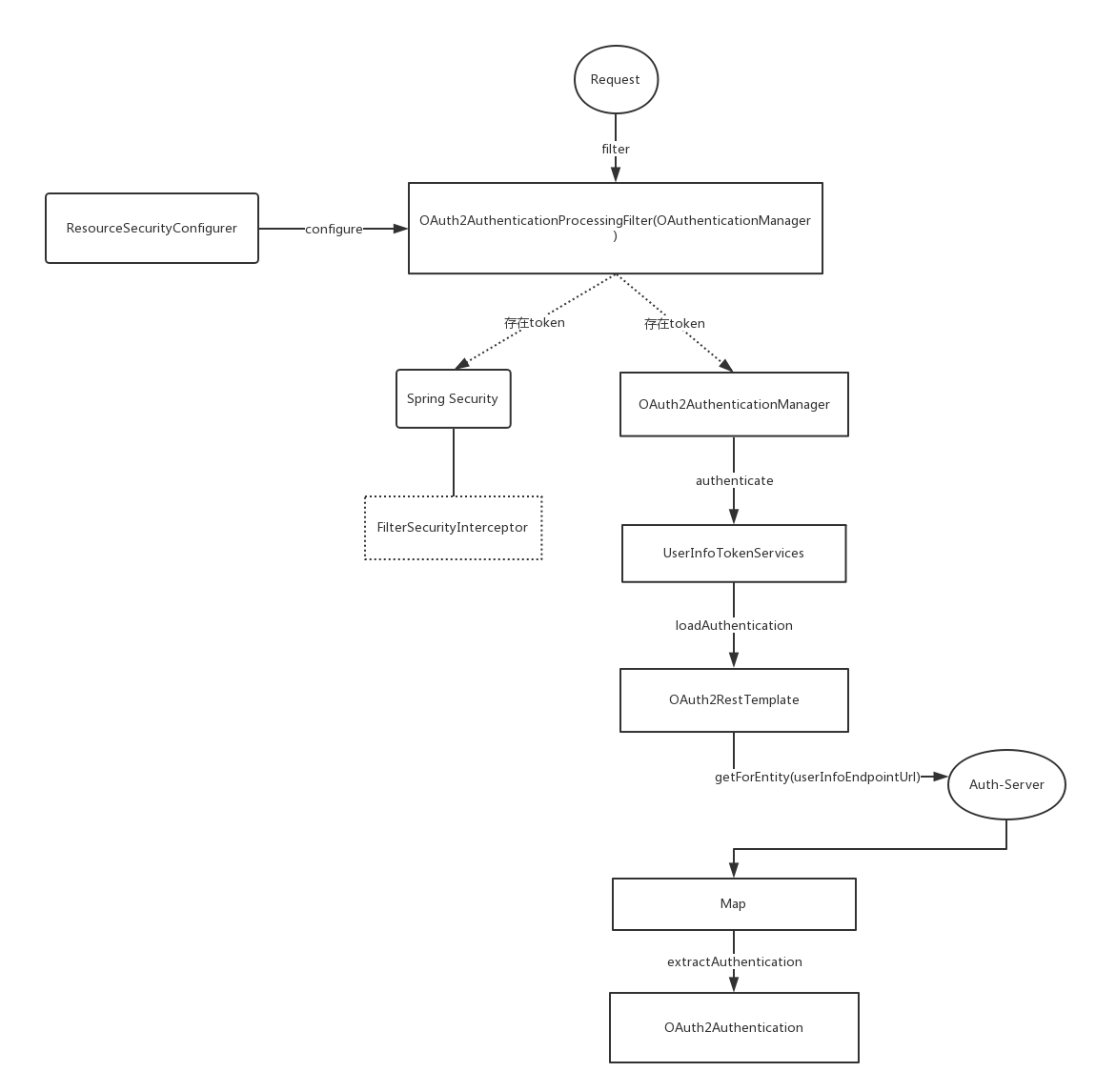Spring Security Oauth2的不同授权方式的认证流程大致可抽象为两部分:
获取token
通过token请求资源
简单实现源码传送门](https://github.com/unknow16/spring-security-family )
前言 先介绍一些工具类接口:
AuthorizationServerTokenServices 提供了创建token,刷新token,获取token的功能
ResourceServerTokenServices 根据accessToken加载客户端信息OAuth2Authentication和根据accessToken获取完整的访问令牌详细信息OAuth2AccessToken
ClientDetails客户端详情,包括clientId,secret,scope(客户端访问范围,默认为空则拥有全部范围),authorizedGrantTypes(授权类型),authorities(客户端可使用的权限)
ClientDetailsService 根据clientId去加载ClientDetails,即OAuth2客户端信息,类似于UserDetailsService
获取token流程 先放一张整体类调用图,后面会详细解释每部分
认证服务器实现,一般会如下配置
1 2 3 @Configuration @EnableAuthorizationServer // 启用认证服务器 public class OAuth2ServerConfig extends AuthorizationServerConfigurerAdapter {
出现了AuthorizationServerConfigurerAdapter 关键类,他关联了三个重要的配置类,分别是
1 2 3 4 5 6 7 8 9 10 11 12 13 14 public class AuthorizationServerConfigurerAdapter implements AuthorizationServerConfigurer { @Override public void configure(AuthorizationServerSecurityConfigurer security <1>) throws Exception{ } @Override public void configure(ClientDetailsServiceConfigurer clients <2>) throws Exception { } @Override public void configure(AuthorizationServerEndpointsConfigurer endpoints <3>) throws Exception { } }
配置AuthorizationServer安全认证的相关信息,创建ClientCredentialsTokenEndpointFilter核心过滤器
配置OAuth2的客户端相关信息,可从db或内存加载
AuthorizationServerEndpointsConfigurer中集中定义了众多相关类的默认实现,可以自定义覆盖,包括配置身份认证器,配置认证方式,TokenStore,TokenGranter,OAuth2RequestFactory等。
ClientCredentialsTokenEndpointFilter 它是一个客户端身份认证核心过滤器,默认获取的端点是/oauth/token, 在请求到达/oauth/token之前经过了ClientCredentialsTokenEndpointFilter这个过滤器,关键方法如下
1 2 3 4 5 6 7 8 9 10 11 12 13 14 public Authentication attemptAuthentication(HttpServletRequest request, HttpServletResponse response) throws AuthenticationException, IOException, ServletException { ... String clientId = request.getParameter("client_id"); String clientSecret = request.getParameter("client_secret"); ... clientId = clientId.trim(); UsernamePasswordAuthenticationToken authRequest = new UsernamePasswordAuthenticationToken(clientId, clientSecret); return this.getAuthenticationManager().authenticate(authRequest); }
这个设计是将client客户端的信息(client_id,client_secret)适配成用户的信息(username,password),这样我们的认证流程就不需要修改了。经过ClientCredentialsTokenEndpointFilter之后,身份信息已经得到了AuthenticationManager的验证。接着便到达了TokenEndpoint。
TokenEndpoint 接受处理/oauth/token端点,生成并返回token。
1 2 3 4 5 6 7 8 9 10 11 12 13 14 15 16 17 18 19 20 @FrameworkEndpoint public class TokenEndpoint extends AbstractEndpoint { @RequestMapping(value = "/oauth/token", method=RequestMethod.POST) public ResponseEntity<OAuth2AccessToken> postAccessToken(Principal principal, @RequestParam Map<String, String> parameters) throws HttpRequestMethodNotSupportedException { ... String clientId = getClientId(principal); ClientDetails authenticatedClient = getClientDetailsService().loadClientByClientId(clientId);//<1> ... TokenRequest tokenRequest = getOAuth2RequestFactory().createTokenRequest(parameters, authenticatedClient);//<2> ... OAuth2AccessToken token = getTokenGranter().grant(tokenRequest.getGrantType(), tokenRequest);//<3> ... return getResponse(token); } private TokenGranter tokenGranter; }
加载客户端信息
结合请求信息,创建TokenRequest
将TokenRequest传递给TokenGranter颁发token, 同时存储
OAuth2AccessToken的实现类DefaultOAuth2AccessToken就是最终得到的token序列化之前的原始类,如下是一个样例token响应:
1 2 3 4 5 6 7 { "access_token":"950a7cc9-5a8a-42c9-a693-40e817b1a4b0", "token_type":"bearer", "refresh_token":"773a0fcd-6023-45f8-8848-e141296cb3cb", "expires_in":27036, "scope":"select" }
TokenGranter 先从UML类图对TokenGranter接口的设计有一个宏观的认识
TokenGranter的设计思路是使用CompositeTokenGranter管理一个List列表,每一种grantType对应一个具体的真正授权者,在debug过程中可以发现CompositeTokenGranter 内部就是在循环调用五种TokenGranter实现类的grant方法,而granter内部则是通过grantType来区分是否是各自的授权类型。
1 2 3 4 5 6 7 8 9 10 11 12 13 14 15 16 17 18 public class CompositeTokenGranter implements TokenGranter { private final List<TokenGranter> tokenGranters; public CompositeTokenGranter(List<TokenGranter> tokenGranters) { this.tokenGranters = new ArrayList<TokenGranter>(tokenGranters); } public OAuth2AccessToken grant(String grantType, TokenRequest tokenRequest) { for (TokenGranter granter : tokenGranters) { OAuth2AccessToken grant = granter.grant(grantType, tokenRequest); if (grant!=null) { return grant; } } return null; } }
五种类型分别是:
ResourceOwnerPasswordTokenGranter ==> password密码模式
AuthorizationCodeTokenGranter ==> authorization_code授权码模式
ClientCredentialsTokenGranter ==> client_credentials客户端模式
ImplicitTokenGranter ==> implicit简化模式
RefreshTokenGranter ==>refresh_token 刷新token专用
思考如何产生token的,则需要继续研究5种授权者的抽象类:AbstractTokenGranter,它中通过AuthorizationServerTokenServices去创建token,并存储token
1 2 3 4 5 6 7 8 9 10 11 12 13 14 15 16 17 18 19 20 21 22 23 24 25 26 27 28 29 30 31 32 33 34 35 36 public abstract class AbstractTokenGranter implements TokenGranter { protected final Log logger = LogFactory.getLog(getClass()); //与token相关的service,重点 private final AuthorizationServerTokenServices tokenServices; //与clientDetails相关的service,重点 private final ClientDetailsService clientDetailsService; //创建oauth2Request的工厂,重点 private final OAuth2RequestFactory requestFactory; private final String grantType; ... public OAuth2AccessToken grant(String grantType, TokenRequest tokenRequest) { ... String clientId = tokenRequest.getClientId(); ClientDetails client = clientDetailsService.loadClientByClientId(clientId); validateGrantType(grantType, client); logger.debug("Getting access token for: " + clientId); return getAccessToken(client, tokenRequest); } protected OAuth2AccessToken getAccessToken(ClientDetails client, TokenRequest tokenRequest) { return tokenServices.createAccessToken(getOAuth2Authentication(client, tokenRequest)); } protected OAuth2Authentication getOAuth2Authentication(ClientDetails client, TokenRequest tokenRequest) { OAuth2Request storedOAuth2Request = requestFactory.createOAuth2Request(client, tokenRequest); return new OAuth2Authentication(storedOAuth2Request, null); } ... }
AbstractTokenGranter中通过AuthorizationServerTokenServices接口的实现类DefaultTokenServices去创建token,然后DefaultTokenServices又用TokenStore存储token。
TokenStore 存储token支持 内存、redis、数据库、等多种方式,对应实现类如下:
内存: InMemoryTokenStore
数据库:JdbcTokenStore
Json Web Key: JwkTokenStore
Json Web Token: JwtTokenStore
redis: RedisTokenStore
通过token请求资源 先放一张整体类调用图,后面会详细解释每部分,下图中如果认证和资源服务分开部署时ResourceServerTokenServices 的实现是UserInfoTokenServices,默认实现是DefaultTokenServices
通过token请求受限资源一般是访问资源服务器,一般配置如下:
1 2 3 @Configuration @EnableResourceServer // 启用资源服务器 public class ResourceServerConfiguration extends ResourceServerConfigurerAdapter {}
我们注意到其相关配置类是ResourceServerConfigurer,内部关联了ResourceServerSecurityConfigurer和HttpSecurity。前者与资源安全配置相关,后者与http安全配置相关。(类名比较类似,注意区分,以Adapter结尾的是适配器,以Configurer结尾的是配置器,以Builder结尾的是建造器,他们分别代表不同的设计模式,对设计模式有所了解可以更加方便理解其设计思路)
1 2 3 4 5 6 7 8 9 10 public class ResourceServerConfigurerAdapter implements ResourceServerConfigurer { @Override public void configure(ResourceServerSecurityConfigurer resources <1> ) throws Exception { } @Override public void configure(HttpSecurity http) throws Exception { http.authorizeRequests().anyRequest().authenticated(); } }
<1> ResourceServerSecurityConfigurer中集中配置了资源服务器默认的实现类,包括ResourceServerTokenServices、TokenStore等。
1 2 3 4 5 6 7 8 9 10 11 12 13 14 15 16 17 18 19 20 21 22 23 24 public void configure(HttpSecurity http) throws Exception { AuthenticationManager oauthAuthenticationManager = oauthAuthenticationManager(http); resourcesServerFilter = new OAuth2AuthenticationProcessingFilter();//<1> resourcesServerFilter.setAuthenticationEntryPoint(authenticationEntryPoint); resourcesServerFilter.setAuthenticationManager(oauthAuthenticationManager);//<2> if (eventPublisher != null) { resourcesServerFilter.setAuthenticationEventPublisher(eventPublisher); } if (tokenExtractor != null) { resourcesServerFilter.setTokenExtractor(tokenExtractor);//<3> } resourcesServerFilter = postProcess(resourcesServerFilter); resourcesServerFilter.setStateless(stateless); // @formatter:off http .authorizeRequests().expressionHandler(expressionHandler) .and() .addFilterBefore(resourcesServerFilter, AbstractPreAuthenticatedProcessingFilter.class) .exceptionHandling() .accessDeniedHandler(accessDeniedHandler)//<4> .authenticationEntryPoint(authenticationEntryPoint); // @formatter:on }
这段是整个oauth2与HttpSecurity相关的核心配置,其中有非常多的注意点,顺带的都强调一下:
创建OAuth2AuthenticationProcessingFilter,OAuth2核心过滤器。
为OAuth2AuthenticationProcessingFilter设置认证OAuth2请求的AuthenticationManager实现,即OAuth2AuthenticationManager类,它并没有被添加到spring的容器中,不然可能会影响spring security的普通认证流程(非oauth2请求),只有被OAuth2AuthenticationProcessingFilter拦截到的oauth2相关请求才被处理。
为OAuth2AuthenticationProcessingFilter设置TokenExtractor默认的实现—-BearerTokenExtractor。
相关的异常处理器,可以重写相关实现,达到自定义异常的目的。
上面提到的OAuth2AuthenticationProcessingFilter、OAuth2AuthenticationManager、TokenExtractor会在下面详解。
OAuth2AuthenticationProcessingFilter 它是OAuth2保护资源的预先认证过滤器,会从请求中提取出token,如果存在会用OAuth2AuthenticationManager进行身份鉴定,然后来填充Spring Security上下文。
主要步骤:
提取token,通过TokenExtractor实现,并封装成Authentication
认证token,通过OAuth2AuthenticationManager认证1中封装的Authentication
1 2 3 4 5 6 7 8 9 10 11 12 13 14 15 16 17 18 19 20 21 22 23 24 25 26 27 28 29 30 31 32 public void doFilter(ServletRequest req, ServletResponse res, FilterChain chain){ final HttpServletRequest request = (HttpServletRequest) req; final HttpServletResponse response = (HttpServletResponse) res; try { //从请求中取出身份信息,即access_token Authentication authentication = tokenExtractor.extract(request); if (authentication == null) { // ... } else { request.setAttribute(OAuth2AuthenticationDetails.ACCESS_TOKEN_VALUE, authentication.getPrincipal()); if (authentication instanceof AbstractAuthenticationToken) { AbstractAuthenticationToken needsDetails = (AbstractAuthenticationToken) authentication; needsDetails.setDetails(authenticationDetailsSource.buildDetails(request)); } //认证身份 Authentication authResult = authenticationManager.authenticate(authentication); ... eventPublisher.publishAuthenticationSuccess(authResult); //将身份信息绑定到SecurityContextHolder中 SecurityContextHolder.getContext().setAuthentication(authResult); } } catch (OAuth2Exception failed) { ... return; } chain.doFilter(request, response); }
这个接口只有一个实现类,它的作用在于分离出请求中包含的token。也启示了我们可以使用多种方式携带token。
在请求头的Authentication中携带
拼接在URL中的以access_token为key的RequestParam
在form表单中以access_token为key提交
OAuth2AuthenticationManager 非OAuth2认证流程中AuthenticationManager的实现类是ProviderManager,但在OAuth2请求中的实现是OAuth2AuthenticationManager,它直接重写了顶级身份认证接口,内部维护了一个ClientDetailService和ResourceServerTokenServices
1 2 3 4 5 6 7 8 9 10 11 12 13 14 15 16 17 18 19 public Authentication authenticate(Authentication authentication) throws AuthenticationException { ... String token = (String) authentication.getPrincipal(); // 1. 借助ResourceServerTokenServices根据token加载身份信息 OAuth2Authentication auth = tokenServices.loadAuthentication(token); ... // 2. 借助ClientDetailService获取ClientDetails,然后和OAuth2Authentication鉴权 checkClientDetails(auth); if (authentication.getDetails() instanceof OAuth2AuthenticationDetails) { OAuth2AuthenticationDetails details = (OAuth2AuthenticationDetails) authentication.getDetails(); ... } auth.setDetails(authentication.getDetails()); auth.setAuthenticated(true); return auth; }
参考资料



